Introduction
Business activity requires a streamlined legal and regulatory system and a public policy that is reliable and accessible to all.1 This includes the rules, regulations, and processes that can help promote an environment conducive to individual entrepreneurship. The extent to which the regulatory framework and public policy are favorable for business creation and operation in a given jurisdiction is known as the ease of doing dusiness.
Studies have shown that, the easier it is to do business, the greater the private sector investment, the more job creation, the more innovation, the higher the salaries, and the greater the economic growth2 —which contributes to more competitiveness, development, and prosperity—; on the contrary, the difficulty of doing business in a place is often an indicator of overregulation, overreach, and inefficiency of government, and places unnecessary burdens on people and their initiatives.
The ease of doing business is vital for foreign direct investment3 and domestic investment; however, it is particularly important for small and medium-sized enterprises (SMEs), because they have less capital and resources. Large companies have the means to afford the costs of excessive regulations for doing business; but a business-friendly environment contributes to the creation of SMEs, with the benefit they bring to the community and society.
People in the process of starting or developing their SMEs need a reasonable, transparent, and fair public policy for the success of their businesses and the achievement of their goals; governmental bureaucracy, burdens, and hindrances are their biggest obstacles. This includes issues such as obtaining permits, registering property, getting electricity, paying taxes, accessing financing, and enforcing contracts, among others.4
It has also been shown that jurisdictions with stricter regulatory environments for entrepreneurship and business creation tend to be more susceptible to corruption. When there are more demands and requirements to comply with, official channels and means are more vulnerable to improper or illicit practice of public functions. Likewise, when the conditions for setting up a business are onerous for SMEs, many people resort to operating informally.
In the informal economy, entrepreneurs, employees, and consumers are often less protected. In addition, businesses are more exposed to special situations such as economic crises and natural events. On the other hand, the government does not receive revenues from businesses that operate informally, and their activities and results are not documented in public records for the purpose of statistical analysis.
It is estimated that 95% of Puerto Rico’s businesses are SMEs with fewer than 50 employees, and that these account for 42% of private sector employment and 36% of total annual payroll.5 Consequently, facilitating the process of creating SMEs can (a) help these key players in increasing potential growth to better manage their resources; (b) contribute to keeping transaction costs low; and (c) be beneficial, in general, for the market and the State.
The ease of doing business is measured in order to know whether or not the legal and regulatory system and public policies are favorable for business creation and operation in a jurisdiction. The possibility of measuring it led to the emergence of tools such as ease of doing business indexes or reports, in which a higher ranking or score indicates higher regulatory quality, lightness of compliance, and protection of private property rights.
The ease of doing business indexes are of great importance, as their rigorous analysis of indicators is used by the private sector to decide where to make their investments.6 The information that these indexes provide is vital for improving living standards, since private investment and the integration of people into productive activity—either by creating a business or working—have proven to be two of the main drivers of socioeconomic development.
Doing Business North America is a study of the ease of doing business in U.S. cities, published by the Center for the Study of Economic Liberty at Arizona State University. The fourth edition of this report features San Juan, for the first time, based on data corresponding to calendar years 2019 and 2020. The study variables are 2% federal,7 70% state, 4% county,8 and 24% city;9 therefore, San Juan’s results can be considered a reflection of Puerto Rico.
What is Doing Business North America?
Doing Business North America is an annual study that provides objective measures of business regulations in the United States of America. This years’ edition covers 83 cities in all 50 states, Washington, D.C., and Puerto Rico. The largest city from each state is included and, in the case of especially large U.S. states, up to five cities have been included. Comprised of over 7,700 datapoints, it uses 93 variables to create 30 data indicators to score and rank cities in regard to how easy it is to set up, operate, and shut down a business.
Over the years, researchers have reported how robust measurement and ranking of regulations that either enhance business activity or constrain it can provide substantial insight into economic outcomes. Objective measurements of those regulations have been vital in this understanding. Between 2002–2020, the World Bank measured and categorized more than 100 different aspects of the laws pertaining to opening, operating, and liquidating a business in the primary business jurisdictions of every country in the world.
The World Bank report, titled Doing Business, scored and ranked cities over a long timeframe and has been an invaluable tool for policymakers and scholars to analyze the beneficial economic improvements that can follow the well-designed liberalization of business regulations and policies. It also gives the ranked jurisdictions a gauge of how well they rank and how far they may have to go to improve the ease of doing business, as well as a history of how far they have already come.
Doing Business North America seeks to provide the same service to scholars and policy makers as the World Bank study. Many studies to date look only at state-level policies; very few focus on the city level. While Doing Business North America is inspired by other similar reports that score and rank locations on the burden of business regulations, this study seeks to drill down further than most of them do. The Doing Business North America report is a project led by the Center for the Study of Economic Liberty at Arizona State University.
Why is this report important?
Provides measurable benchmarks. This report provides objective measurements of regulatory conditions and makes them publicly available to researchers and policymakers.
Encourages competition. This report allows researchers and policymakers to track the improvement or decline in local regulatory conditions and provide a context for thinking about policy reform.
Increases economic well-being. The measures can help contribute to the understanding of which regulatory environments can produce the best economic outcomes for the largest number of people.
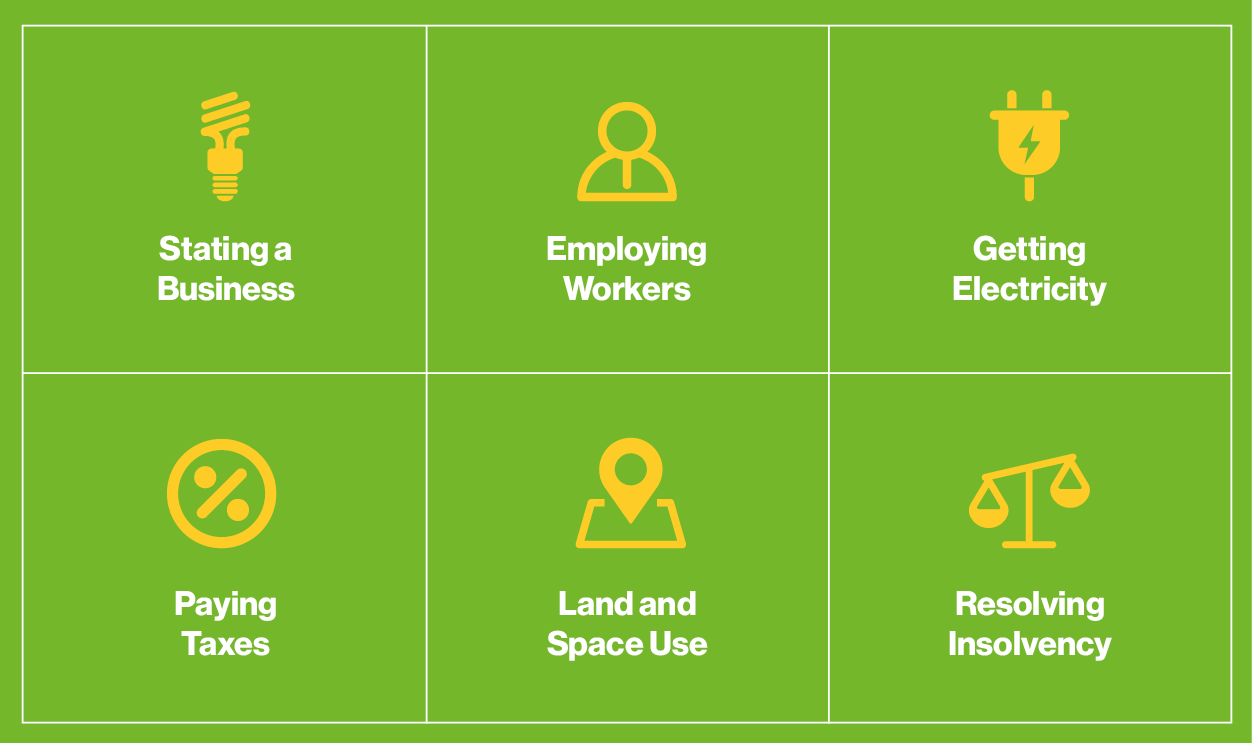
Methodology Overview
In this year’s edition, there are six categories in which the cities were scored and ranked: “Starting a Business,” “Employing Workers,” “Getting Electricity,” “Paying Taxes,” “Land and Space Use,” and “Resolving Insolvency.” These categories are composed of a total of 93 regulatory and economic variables grouped together into a total of 30 scored variables. For each indicator, there is a top performer and a bottom performer. Economies with the best performance for a given indicator are awarded 10 “points,” or a score of 10. Cities at the level of bottom performance or cities at or below two standard deviations from the mean are awarded a score of 0. All the cities in between are scored based on their distance to the frontier. For each city, the number of awarded points across all indicators is aggregated, then divided by the number of indicators for which we had data. This is done because not all locations have complete data across all indicators and doing so allows for all locations to be included in comparison. The data collected came entirely from publicly available sources, many of which were published by the government itself.
1. Starting a Business | What does starting a business measure?
Doing Business North America records all procedures officially required for an entrepreneur to start up and formally operate a limited liability company (LLC), as well as the time and cost to complete these procedures. These procedures include the processes entrepreneurs undergo when obtaining all necessary approvals, licenses, and permits, and completing any required notifications, verifications, or inscriptions for the company and employees with relevant authorities. It does not include steps related to keeping a business compliant. For example, it does not include steps related to obtaining licenses and permits, which is generally a necessary step to continue legal operation. Information is also collected on the sequence in which procedures are to be completed and whether procedures may be carried out simultaneously. It is assumed that any required information is readily available and that the entrepreneur will pay no bribes.
The “Starting a Business” category was ranked and scored using the following three indicators:


Data for this category was obtained from various departments within each state and jurisdiction, particularly the secretary of state’s office and state and local corporate or small business divisions.
For details about the assumptions and indicators, refer to the full report in pdf.
2. Employing Workers | What does employing workers measure?
Doing Business North America records a myriad of variables related to the flexibility and regulation of employing workers, specifically as it relates to the areas of hiring, working hours, laying off workers, and leave. There are 13 indicators used to represent the legal requirements or fiscal burdens necessary to comply with an economy’s labor laws.
The “Employing Workers” category was ranked and scored using the following variables:


Data for this category was obtained from national bureaus of labor, state and provincial offices of labor/employment/ economic security, and local government documents.
For details about the assumptions and indicators, refer to the full report in pdf.
3. Getting Electricity | What does getting electricity measure?
The Doing Business North America report collects information related to the accessibility, reliability, and cost of electricity. The Doing Business North America project uses the Annual Electric Power Industry Report produced by the U.S. Energy Information Administration to collect information on the number of providers for a given state. In addition, two metrics of electricity reliability are collected: the System Average Interruption Duration Index (SAIDI) and the System Average Interruption Frequency Index (SAIFI). Finally, this project measures the cost of electricity by measuring the average price for a kilowatt-hour (kWh) of electricity for use in a commercial property.
The “Getting Electricity” category was ranked and scored using the following four indicators:


Data for this category was obtained from each jurisdiction’s department of electricity and the U.S. Census Bureau.
For details about the assumptions and indicators, refer to the full report in pdf.
4. Land and Space Use | What does land and space use measure?
Doing Business North America records the full sequence of procedures necessary for a business to purchase a property from another business and to transfer the property title to the buyer’s name, so that the buyer can use the property for expanding its business and as collateral in taking new loans or sell it to another business. The process of transferring property starts with pre-registration procedures, including: (i) obtaining the necessary documents, such as a copy of the seller’s title if necessary; and (ii) conducting due diligence if required. The transaction is considered complete when it is opposed to third parties and when the buyer can use the property as collateral for a bank loan or resell it. Every procedure required by law or necessary in practice is included, whether it is the responsibility of the seller or the buyer or must be completed by a third party on their behalf.
Doing Business North America also measures the cost to complete each of these procedures. In addition to the procedures to transfer title on immovable property, there is also a measure of the quality of the land administration system in each economy. The Quality of Land Administration Index is comprised of two sub-indexes: A Reliability of Infrastructure Index and a Transparency of Information Index. Finally, information on the number of approvals needed in both the zoning and re-zoning process is collected. The survey questions used here are a subset of the questions used in the Wharton Residential Land Use Regulatory Index. In this case, the data collected was that which pertains to commercial property instead of residential property.
The “Land and Space Use” category was ranked and scored using the following variables:
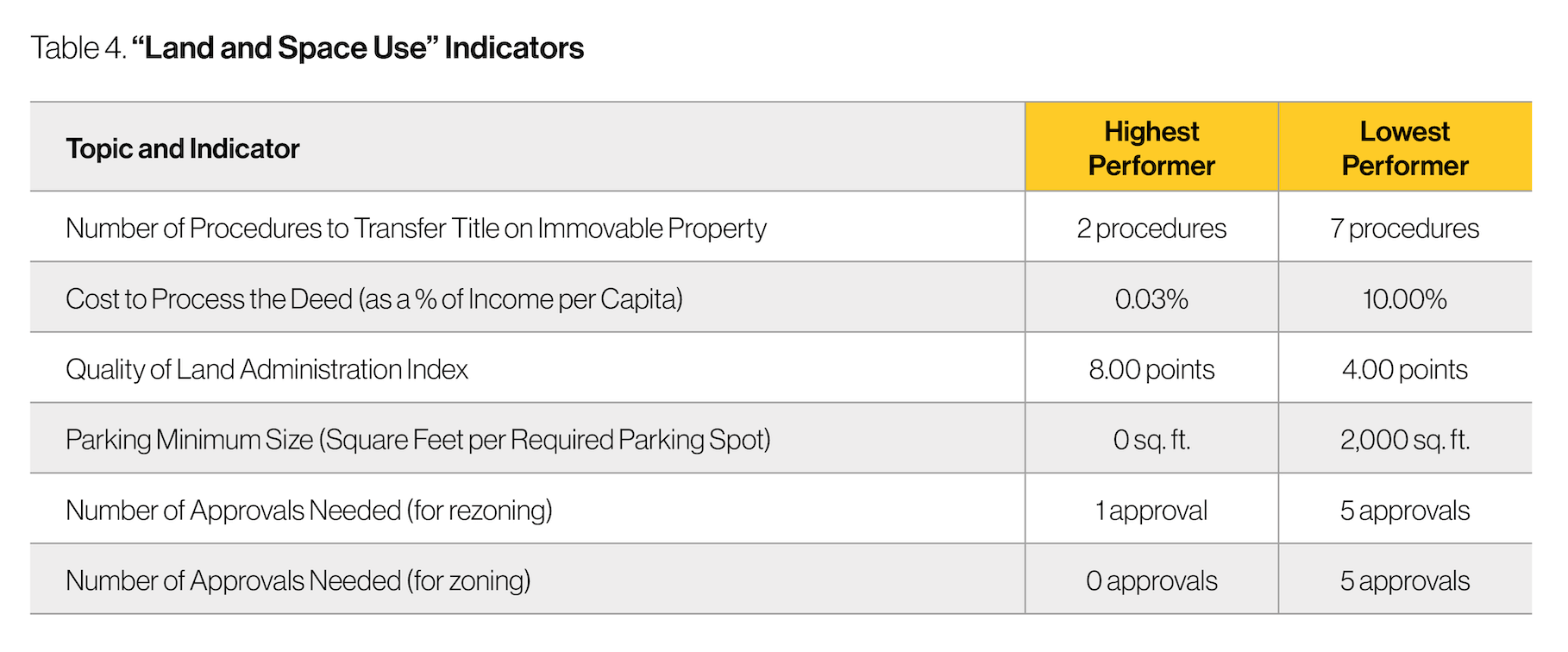

Data for this category was obtained from county/local deed recorder offices, city zoning ordinances, city codes, city council documents, and zoning board documents.
For details about the assumptions and indicators, refer to the full report in pdf.
5. Paying Taxes | What does paying taxes measure
Doing Business North America measures all taxes that are mandated at any level of government (including federal, state, and city). Indicators related to personal, corporate, and commercial property tax rates are collected to provide a full spectrum of taxes that businesses, employers, employees, and city residents can expect to pay.
The “Paying Taxes” category was ranked and scored using the following variables:
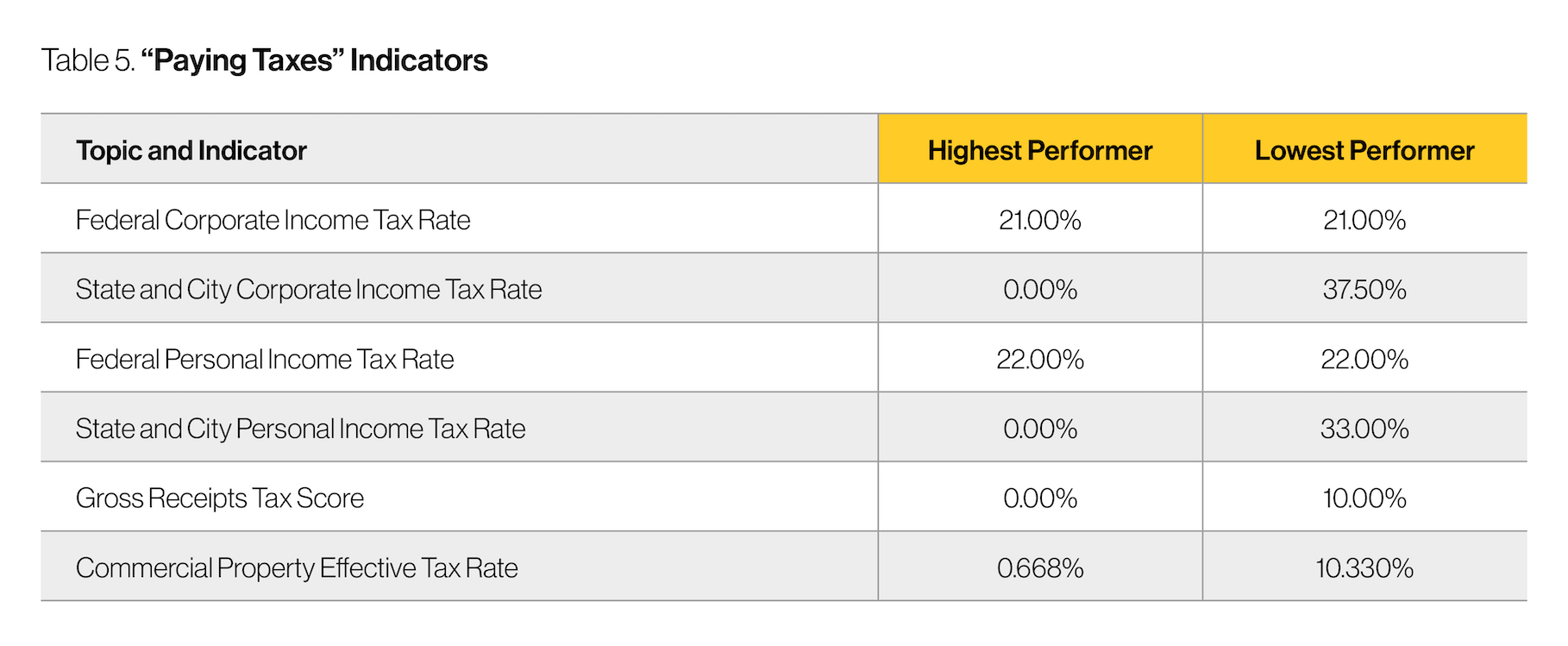

Data for this category was obtained from federal, state, and local revenues/tax offices and tax practitioner and policy organizations.
For details about the assumptions and indicators, refer to the full report in pdf.
6. Resolving Insolvency | What does resolving insolvency measure
Doing Business North America studies the time, cost, and outcome of insolvency proceedings involving domestic entities as well as the strength of the legal framework applicable to judicial liquidation and reorganization proceedings. Indicators related to time and the strength of the legal framework index are used to calculate the regulatory performance for resolving insolvency.
The “Resolving Insolvency” category was ranked and scored using the following two indicators:


Data for this category was obtained from the World Bank’s Doing Business 2020.
For details about the assumptions and indicators, refer to the full report in pdf.
What is the Ease of Doing Business Score?
The primary objective of the Doing Business North America 2022 report is to provide a measure of the ease of doing business for cities in United States and Puerto Rico. At least one city per state was scored. The District of Columbia was included as well. For states with much larger populations than average, more cities (up to four of the largest in the state) were included. The ease of doing business score is derived from a summation of the scores awarded in each of the six categories measured by this report. The ease of doing business score focuses on the regulatory burdens a small to medium-sized business would face from the birth of the business to its death. The following explains the process of arriving at the final score.
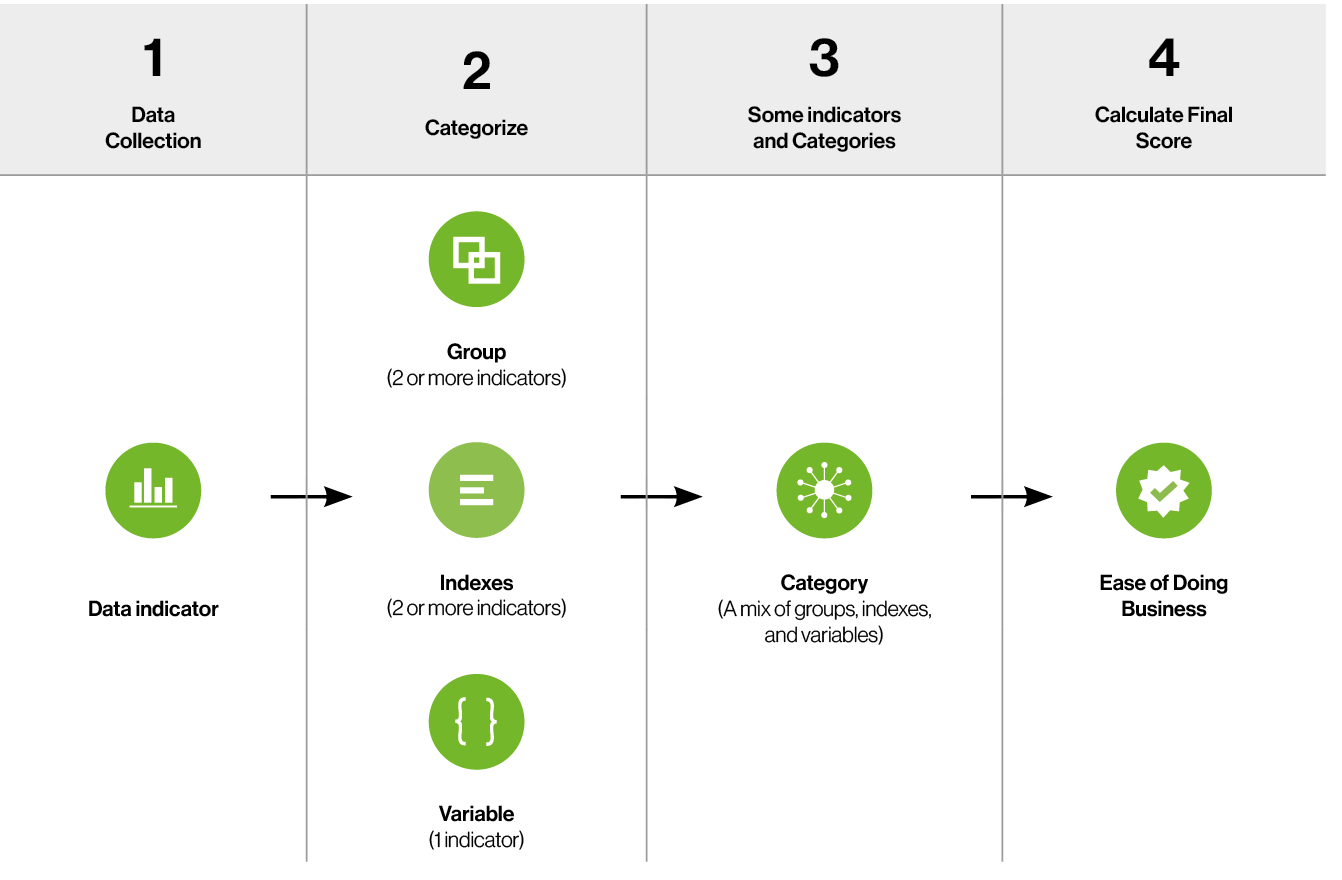

Steps 1 and 2: Collecting and Categorizing the Data
The Doing Business North America team collected data on 111 different regulatory and economic indicators across six different categories. The data collected came entirely from publicly available sources, including many published by the municipal governments we studied. Each observation is termed an “indicator.” Once collected, these indicators were then classified into one of three types: (i) a variable, (ii) a group, or (iii) an index.
For the variable, groups and index definitions, refer to the full report in pdf.
Step 3: Scoring the Indicators and Categories
The indicators are scored following one of two procedures, depending on whether the data type is binary in nature (which is collapsed into indexes) or continuous in nature (which becomes variables on their own or combined in groups). Indexes and groups are also scored.
For the binary indicators, continuous indicators, group, indexes and scoring the categories, refer to the full report in pdf.
Step 4: Calculating the Ease of Doing Business Score
The ease of doing business score is derived by averaging the indicator scores across all categories. Any effect of missing data is significantly reduced at this level of aggregation. This number is then multiplied by 10 to allow the final score to resemble a percentage (i.e., out of 100%).
Ease of Doing Business Score and Rankings
The score and ranks below are an overall measure of the ease of doing business for small-and-medium-sized businesses in each city. It is composed of the scores of all six categories included in the Doing Business North America 2022 Report.


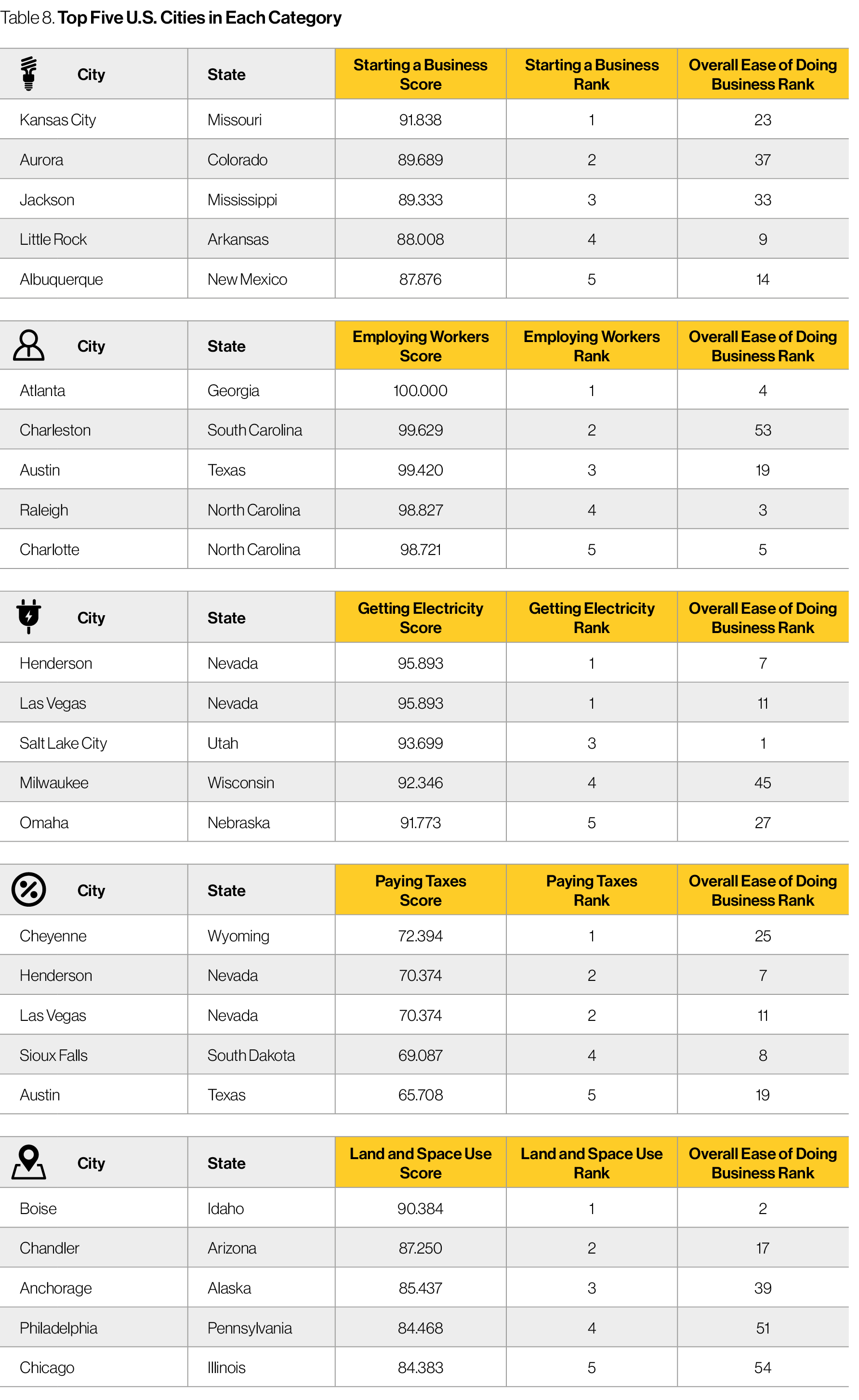

City Rankings


For more information on the rankings by city visit https://dbna.asu.edu/rankings.
For other ways to visualize the data visit https://dbna.asu.edu/data.
This work is a compendium of Doing Business North America 2022 Report, 4th Edition produced and published by the Puerto Rico Institute for Economic Liberty.
Download all the data, ranks, scores, and methodology at: dbna.asu.edu.
Doing Business North America 2022
Doing Business North America 2022 is published by the Center for the Study of Economic Liberty (CSEL), a joint research endeavor of the W. P. Carey School of Business and the School of Civic and Economic Thought and Leadership at Arizona State University. The CSEL plans to become an international leader in research that affects liberty-enhancing public policy and increases public and academic awareness of the history and philosophy of economic liberty by leveraging our place, fusing academic research with policy engagement, and engaging globally to transform society. Information about the center, its research activities and public programs can be found at csel.asu.edu.
Partner
The Institute for Economic Liberty (ILE) is a 501(c)(3) non-profit, non-partisan, non-governmental free-market think tank created with the genuine desire to ensure that everyone in Puerto Rico has equal opportunities to unleash their maximum potential and create their own success. We believe that effort and merit should be rewarded and prosperity should be driven by people’s creativity, entrepreneurship, and innovation. We want to live in a Puerto Rico where everyone can be empowered to achieve their goals and progress in a free and open society. You can learn more about ILE at ilepr.org, as well as on Facebook, Instagram, LinkedIn, and Twitter @ilepuertorico.
People
- Ross Emmett, Director and Professor, Center for the Study of Economic Liberty, ross.emmett@asu.edu
- Mason Hunt, Assistant Director, Center Projects and Initiatives, Center for the Study of Economic Liberty, mason.hunt@asu.edu
- Ángel Carrión-Tavárez, Director of Research and Public Policy, Instituto de Libertad Económica para Puerto Rico, carriona@ilepr.org
Contact
Arizona State University
Center for the Study of Economic Liberty
Creativity Commons, Suite 490
501 E Orange Street
PO Box 879801,
Tempe AZ 85287-9801
Teléfono: 480-965-0329
Fax: 480-965-0748
Correo: economicliberty@asu.edu
Instituto de Libertad Económica para Puerto Rico
PO Box 363232
San Juan PR 00936
Teléfono: 787-721-5290
Fax: 787-721-5938
Correo: info@ilepr.org
Citation
The compendium
Carrión-Tavárez, Á. (Ed.). (2023). Doing business North America 2022 report (4th ed., Compendium) (Center for the Study
of Economic Liberty). Arizona State University. https://doi.org/10.53095/13583004
The introduction
Carrión-Tavárez, Á. (2023). Introduction. In Center for the Study of Economic Liberty, Doing business North America 2022
report (4th ed., Compendium, pp. 5-6). Arizona State University. https://doi.org/10.53095/13583004
The original work
Center for the Study of Economic Liberty. (2023). Doing business North America 2022 report (4th ed.). Arizona State
University. https://dbna.asu.edu
1 Ver Ani, T. G. (2015). Effect of ease of doing business to economic growth among selected countries in Asia. Asia Pacific journal of Multidisciplinary Research, 3(5), 139-145.
2 See Bétila, R. R. (2021). The impact of ease of doing business on economic growth: A dynamic panel analysis for African countries. SN Business & Economics, 1(10), 144; Canare, T., Ang, A., & Mendoza, R. U. (2016). Ease of doing business: International policy experience and evidence. SSRN. https://doi.org/10.2139/ssrn.2834757, Leal Rodríguez, A. L., & Sanchís Pedregosa, C. (2019). Could the ease of doing business be considered a predictor of countries’ socio-economic wealth? An empirical analysis using PLS-SEM. Journal of International Studies, 12(4), 229-243; y R. S., Jacomossi, R. R., Barrichello, A., & Feldmann, P. R. (2023). The interdependence between ease of doing business, innovation, and competitiveness of nations. Brazilian Administration Review, 20(2), 1-14. https://doi.org/10.1590/1807-7692bar2023220103.
3 See Xu, X., Hu, Y., & Tahir, S. H. (2023). Nexus between ease of doing business and foreign direct investment: Evidence from 130 economies. In E3S Web of Conferences (Vol. 409, p. 06015). EDP Sciences. https://doi.org/10.1051/e3sconf/202340906015
4 In a survey conducted by the Financial Oversight and Management Board for Puerto Rico in 2021, 88% of entrepreneurs stated that obtaining permits is a difficult task—and 54% of them expressed that it is very difficult—, for reasons such as the lack of clarity of the requirements, the multiple entities involved, and the disinterest of public officials. Respondents also felt that the cost and process of registering property is high, difficult, and ineffective; and that Puerto Rico’s tax structure is costly and complex. The results of this survey on the ease of doing business in Puerto Rico are available at https://juntasupervision.pr.gov/encuesta-de-la-facilidad-para-hacer-negocios/.
5 The data comes from the 2017 County Business Patterns published by the U.S. Census Bureau and Ojeda, G. (2022, March 1). La facilidad para hacer negocios en Puerto Rico: un reto continuo. Sin comillas. https://sincomillas.com/la-facilidadpara-hacer-negocios-en-puerto-rico-un-reto-continuo/.
6 See Anggraini, R. F., & Inaba, K. (2020). The impact of the ease of doing business on foreign direct investment. The Ritsumeikan Economic Review, 69(3), 393-421.
7 The federal personal and corporate income tax variables did not apply to Puerto Rico.
8 The county variables on zoning and rezoning did not apply to Puerto Rico.
9 During the investigation it was observed that some state entities in Puerto Rico do not function as a one-stop shop; for example, the Oficina de Gerencia y Presupuesto (Office of Management and Budget) has several permitting entities under it and the Junta de Planificación (Planning Board) has power over future development, zoning, and rezoning throughout the Island, but devolves some of its powers to certain municipalities such as San Juan (K. Rose, personal communication, November 29, 2022). This diversity complicates the analysis and calculation of ratios with other jurisdictions, as processes and information can be classified as state or city depending on the municipality and how the data is recorded.


